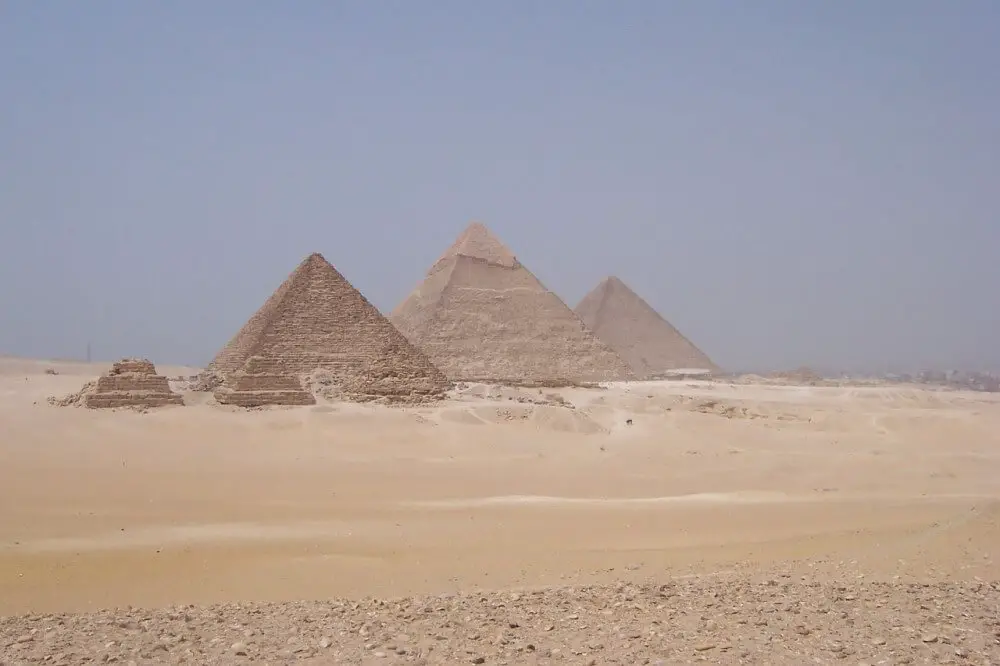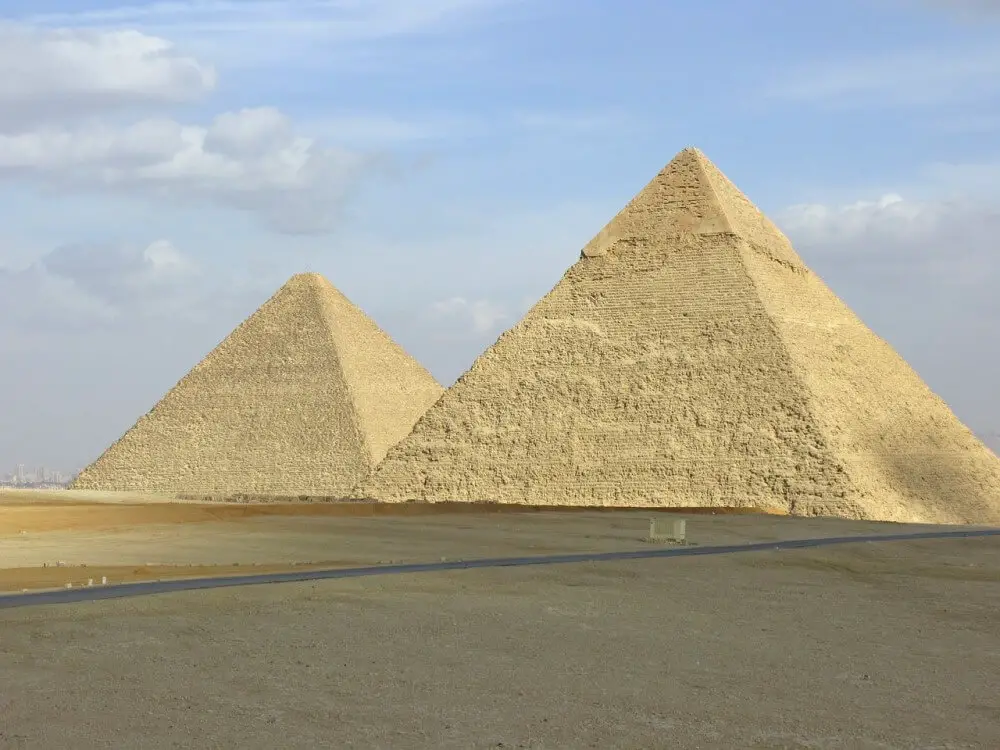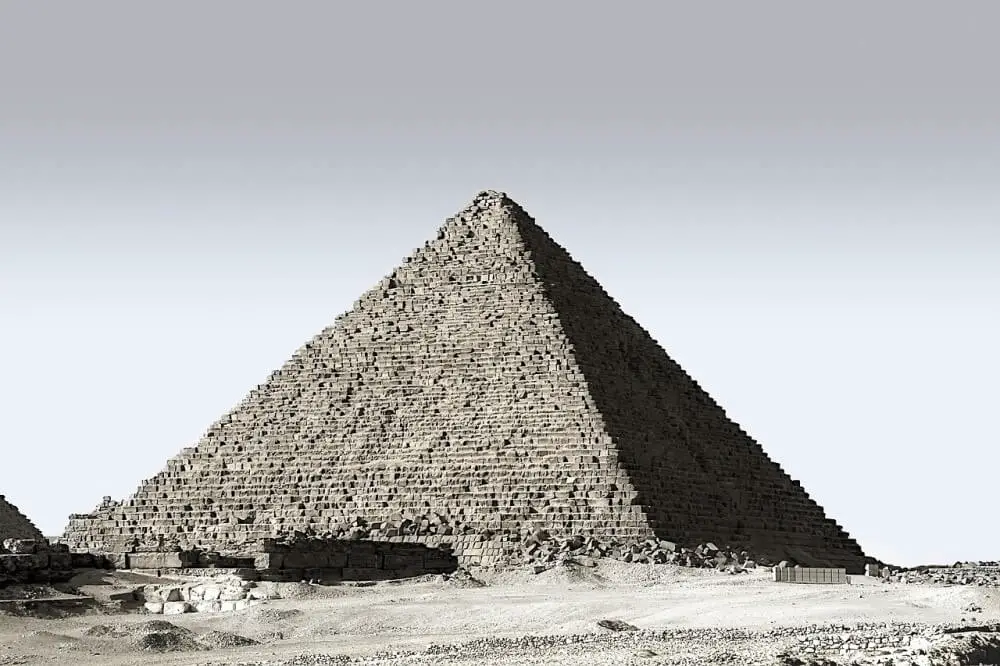There’s not many buildings in the world whose dimensions are so impressive that many wonder how they could have even been built. But that’s exactly the case with the iconic Pyramids of Giza, which have been the source of architectural admiration and wonder for over 4,500 years.
But, to get to the source of the Pyramids’ mystery, we must first understand how and why they got this wondrous reputation in the first place. Namely, what makes them such architectural marvels, and what gaps there are in the Pyramids’ construction story.
With this in mind, let’s explore the question: why is it such a mystery how the Pyramids were built?
In short, the sheer precision, scope and endurance of the Pyramids are the main factors behind the mystery behind the Pyramids’ construction. The iconic structures were built to proportions both so accurate and gigantic that it seems almost unbelievable for the time period in which they were built. Additionally, the lack of reliable records that remain from the time of construction also contribute to the lack of knowledge on the topic.
Read on to find out what conspiracy theories surround the Pyramids construction, how much we currently know about how the Pyramids were constructed, and whether aliens really did build the structures.
But first, let’s explore the question of why there are mysteries surrounding the Pyramids in more detail.
Explore our related articles:
Explore our related articles:
Top 10+ Oldest Buildings in ChicagoDid the Pyramids have Gold Tops?
Top 20 White Elephant Construction Projects Around the World
White House vs Capitol Building: What is the Difference?
Top 10+ Construction Projects in Liverpool (2023)
Would it be Possible to Build the Pyramids Today?
Which Current Buildings will Last the Longest?
Building precision
One of the main reasons behind why the Pyramids’ construction is so mysterious is the precision in which its stones were placed. The Pyramids were built in approximately 2570 BC, yet despite their advanced age were built to immaculately accurate proportions.
For instance, the 455 foot tall Great Pyramid of Giza is built to within roughly 0.05 degrees of perfect cardinal alignment. And, at the time of completion, its stones were levelled to within a fraction of an inch all the way around its vast superstructure.
To achieve this level of precision would be somewhat impressive even with today’s technology, including computer imagery and specially crafted tools. But to achieve this around 4,500 years ago is a mammoth task that has still not been fully worked out by modern archaeologists, despite many theories surfacing.
Scope of construction
In a similar vein, the sheer scope of the Pyramids has wowed historians, architects and archaeologists for millennia, particularly in the context of the time period of its construction.
Of course, at that stage, there was no electronic assistance or heavy machinery to hoist materials around the site. Instead, it is thought to have taken over 30,000 people to manually lift the mammoth limestone blocks from the River Nile to the Pyramid site, where they were then placed on a stepped decline slope.
From here, a technique called ‘Cyclopean Masonry’ was employed to fit the stones together. This meant the blocks were placed down so neatly that there was no need for any glueing substance, such as mortar or adhesive.
Put simply, this was a feat of construction that almost defies belief.
And it’s from this that some mystery can be drawn; who exactly were these workers, was it slave or skilled labour, and what other methods did they use to aid the process? We have a good indication of some answers today, but in truth there’s still a lot that we don’t know.

Design and purpose
Another facet to the mystery of the Pyramids’ construction is the original usage and purpose of the structures. After all, while they were built to be, and still remain awe-inspiring in a visual sense, they were built for practical reasons.
The main functional reason the structures were constructed was to act as tombs for the Pharaohs, who were the Ancient Egyptian equivalent of kings. In the period of their construction, the Pyramids were a reflection of the age and its firm belief in life after death.
Indeed, the tiered design featured on its exterior was intended to be a stairway for the pharaoh to climb to the sun god.
But, we know that there is more to the Pyramids than meets the eye. For, inside their walls, there are hidden tunnels and chambers that snake hundreds of metres through the structure. There are three known in the Great Pyramid, which are the King’s Chamber, the Queen’s Chamber and the unfinished Subterranean Chambers.
But, there are likely to be more chambers to discover. In 2017, a significant find was made using muon radiography in the Great Pyramid of Giza. A large empty space above the Grand Galley, named the Big Void, was detected, with an estimated cavity length of 98 feet.
However, the purpose of this space is still to be figured out. As they have done with many aspects of the Pyramids, scientists are using modern technology to try and work out what the purpose of the void is. Despite the employment of such gadgetry, no answer has been found.
It’s one of the many small mysteries that make up the bigger puzzle: finding out not only what remains to be discovered within the Pyramids themselves, but also what it may reveal about the Ancient Egyptians.
Record keeping through the ages
Of course, a more direct cause for mystery when considering how the Pyramids were built is the fact that records from the era have largely been lost in the intervening years. Unfortunately, there are no surviving records of the exact construction process, which means we can only make educated guesses as to how it was achieved.
In 2013, a French archaeologist discovered a collection of papyri near the Red Sea coast that uncovered how the day-to-day construction work was managed. Although this did not provide technical details about architecture and logistics, it still provided valuable insights for future architects and historians.
For instance, one thing it did do was eliminate the chances of the Pyramids being built by ancient civilisations or aliens, as some conspiracy theories have suggested.

How much do we know about how the Pyramids were built?
At present, we have a fairly good understanding of how the Pyramids were built. However, this is far from complete, and there are many aspects to its construction that we still do not know about.
For example, beyond any reasonable doubt, we know that the limestone blocks that comprise the exterior of the Pyramids first had to be quarried and transported along the River Nile. Then, workers had to drag these stones to the base of the Pyramids, where they were hoisted manually to their respective placement spots.
As to how the stones were placed so accurately, it is thought that the Egyptians used the pole star or the sun’s shadow to position the stones on a perfect alignment. To do this, they may have used the autumnal equinox, which occurs twice a year and represents equal days and equal nights.
However, even now, aspects of the Pyramids’ construction are still debated and discussed in many circles. After all, with the primitive technology available to them, it’s simply astonishing that the Ancient Egyptians were able to pool all the resources together to build such a magnificent structure.
What conspiracy theories are there about the construction of the Pyramids?
In the many years since its construction, many conspiracy theories have surfaced about how the Pyramids were built. Some of the main conspiracy theories are that aliens or lost civilisations were responsible for their construction, or that the Ancient Egyptians time travelled to make its building possible.
The aliens theory, for one, contends that the Ancient Egyptians did not have the knowledge or technology to achieve the precision evident in the Pyramids construction. According to this theory, extraterrestrial beings were the parties responsible.
In a similar vein, the lost civilisation theory also asserts that the Egyptians were not capable of constructing the Pyramids. However, instead of extraterrestrials, this theory suggests that there was another ancient civilisation that possessed the tool to do the job. This civilisation has since been lost and its knowledge forgotten.
Meanwhile, other theories claim that while Ancient Egyptians did build the Pyramids, they had the help of alien technology that was perhaps passed down from a time travelling future civilisation. Indeed, some claim that they were built by other groups altogether, such as the Hebrews or Atlanteans.
Of course, it’s worth pointing out that, as the name suggests, these conspiracy theories are conspiracies only. Until we get some concrete evidence that any one is true, it’s hard to disagree with the historical consensus that the Pyramids were indeed built solely by the ancient Egyptians.

Did aliens really build the Pyramids?
Put simply, there is absolutely no evidence that aliens were responsible for the Pyramids. There’s no doubt that the advanced architectural and building methods that were used in their construction were astonishing, but this was a remarkable achievement likely accomplished by the ancient Egyptians themselves.
The alien theory stems from a wider ranging conspiracy theory which is sometimes referred to as ‘paleocontact’. Those who believe in this theory purport that aliens have visited Earth at various points to assist in key construction projects, with the Pyramids being among them.
However, we have enough records and archaeological evidence in modern times to suggest that this theory is highly improbable. The extensive archaeological record of the Pyramids includes evidence of tools, construction sites, and even workers’ settlements, and it all points to human ingenuity and effort as the driving force behind the construction of the pyramids.
Therefore, while the idea of aliens building the pyramids may be popular in certain fringe circles, it does not align with the consensus view supported by scientific evidence and scholarly research.
That’s it for our handy guide to why there is such mystery surrounding the construction of the Pyramids. As we’ve discovered, it’s with good reason that there’s very few buildings worldwide that have had more written and spoken about them.
Indeed, perhaps the most amazing thing about the Pyramids is purely the fact that, even after 4,500 years, there’s still so many mysteries to uncover.
For more related news, views and in-depth guides, explore more of our general building articles. They feature a guide to which buildings will last the longest, as we discuss which structures could last even longer than the Pyramids have done already.
Or, if you’d like more guides to building and architecture vocabulary, take a look at our selection of building wikis, including what the definition to ha-ha is.
Last Updated on 17 September 2023 by Michael